By Paul Fawcett
The death of a public safety professional in the line of duty is the worst-case scenario, the one you hope will never happen. Unfortunately, the reality is that because of the hazardous nature of the work, it’s something that you may be faced with. As horrific as it is to contemplate, you need to be prepared. Just like operational planning and training improve performance and reduce mishaps, decedent affairs planning and training will reduce confusion and stress when the unthinkable happens.
Preplanning for Decedent Affairs
Preparing in advance for the unthinkable will allow you to refer to a policy or instruction you’ve developed so that when it happens you don’t have to make it up as you go. Your policy should designate a decedent affairs officer (DAO), who guides the process, coordinates administrative items, briefs senior staff, preps notification teams, and advises on key issues such as dissemination of information and public affairs. Don’t wait until the fatality occurs; designate DAOs in advance and allow them to become familiar with the policy.
If your organization doesn’t have a decedent affairs policy, your newly appointed DAO may assist with writing it in conjunction with your human resources (HR) office and legal counsel. Decedent affairs policies are at the juncture of HR, law, honors and ceremonies, social services, and operations. Add in the human emotions factor, and decedent affairs becomes a complex evolution. You need to consider all aspects when developing the policy and instruction.
Key participants in a decedent affairs case are the contact officer for the deceased’s next of kin and the notification team. It’s often not possible to select these members in advance, as they are normally selected at the time of the event based on seniority, experience, and connection to the deceased. Therefore, you may want to provide unit or station level training once a year for potential notification team members and contact officers. Generally, an hour will cover the basics of what is expected of an officer selected for these roles and how to execute these tasks.
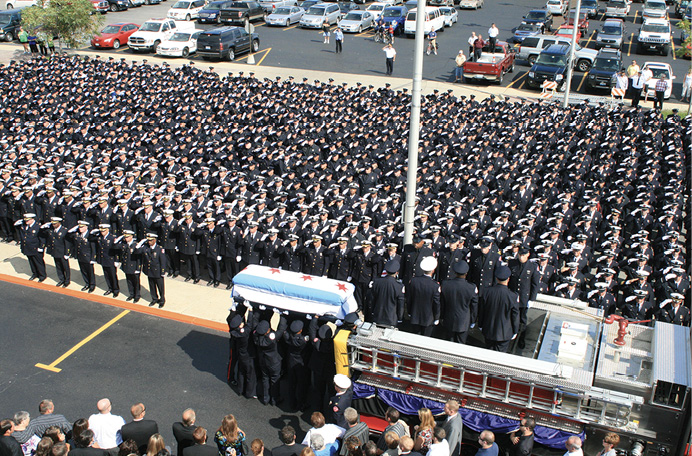
(1) Photos by Tim Olk.
Notification of Next of Kin
Your decedent affairs policy should outline who makes notification to the family of the deceased. Many public safety agencies want to make that notification themselves and not leave it to local law enforcement. That’s completely understandable, but it comes with some challenges. In a best of the worst-case situation, your notification team will be able to get into dress uniform, gather some basic facts about what happened, and determine who the next of kin are and where they are located.
Notification teams should be small—two to three members. Too many participants can overwhelm the next of kin. Never send someone alone to perform this difficult task. The team should be experienced and senior enough to handle the stress of the situation. If your organization has a chaplain, you may want to consider sending him as the third team member if appropriate. One member of the team should be designated as the contact for the family for any questions they have or anything they need to help them through the administrative and ceremonial processes. This should be someone who can visit the family regularly over the first few weeks; it should also be someone the organization can spare from regular duties. If it’s someone the family already knows and trusts, that will help considerably.
Before the team departs for notifications, they should discuss exactly who will talk, what they will say, to whom, and how. It’s best to make the death notification indoors with the family seated. The notification officer should sit or kneel next to or in front of the next of kin to be at eye level. Reaction to an unexpected death can take many forms. Be prepared to step back if it becomes physical. If the family asks the team to leave, go immediately.
In the case where the deceased doesn’t have family locally but does have next of kin at a distance, you’ll need to determine how best to handle that. You can contact local law enforcement at the next of kin’s location and ask them to assist. Avoid initial notification by phone if possible.
You need to do next of kin notification correctly, so a few extra minutes preparing can make it go smoother. However, you are trying to ensure the family gets notified by official channels and not traditional media or social media. Ask your staff already in the know to stay off social media until notification is made. If you are approached by traditional media outlets, tell them that a statement is forthcoming but to allow you to notify the family first. They may or may not respect your request.
Of critical importance is making the time-sensitive line-of-duty death notifications to both the federal Public Safety Officers’ Benefit program as well as any existing state benefits programs. These programs require significant amounts of documentation within a specific time frame. Familiarize yourself with their requirements.
Personal Effects
Personal effects may seem like a minor detail at the time of the incident but will not be later. The deceased may have personal effects on them at the time of death—ID, wallet, rings, or watches, not to mention uniforms and organizational gear. They may also have personal items at the unit or station house. When working with medical staff at the hospital immediately after declaration of death, ask if you can take custody of personal effects in the deceased’s possession at the time of death. This reduces the possibility of their being lost or stolen. Reclaiming the ID also eliminates the inevitable question: “Are you sure who it is?” You are sure because you reclaimed the ID from the deceased.
Place the reclaimed items in a bag labeled with the deceased’s name and chain of custody information; an evidence bag is ideal. Lock it in a safe that is accessible to the DAO. If the personal effects aren’t released at the hospital because they are considered evidence, ask the medical staff for an inventory and a copy of the ID for your records.
Inventory and record personal items at the station, box them up, and secure them until releasing them to the next of kin. Don’t release any personal effects until you determine who is entitled to have them. In cases of divorces, separations, or parent/spouse conflicts, this may not be simple to determine. When in doubt, check your policy. If it’s still not clear, check with your agency’s attorney.
Effect on the Crew
Once you’ve made notification to the next of kin, turn your attention to your team. The first item is to ensure that they are notified correctly. The deceased was a teammate, coworker, and friend. The nature of public safety work tends to build stronger interpersonal bonds among the crew than in other occupations because of shared rigorous training, shared hazardous duty, and communal living during multiday shifts. Thus, the death of one of their own will likely have a significant impact on the crew.
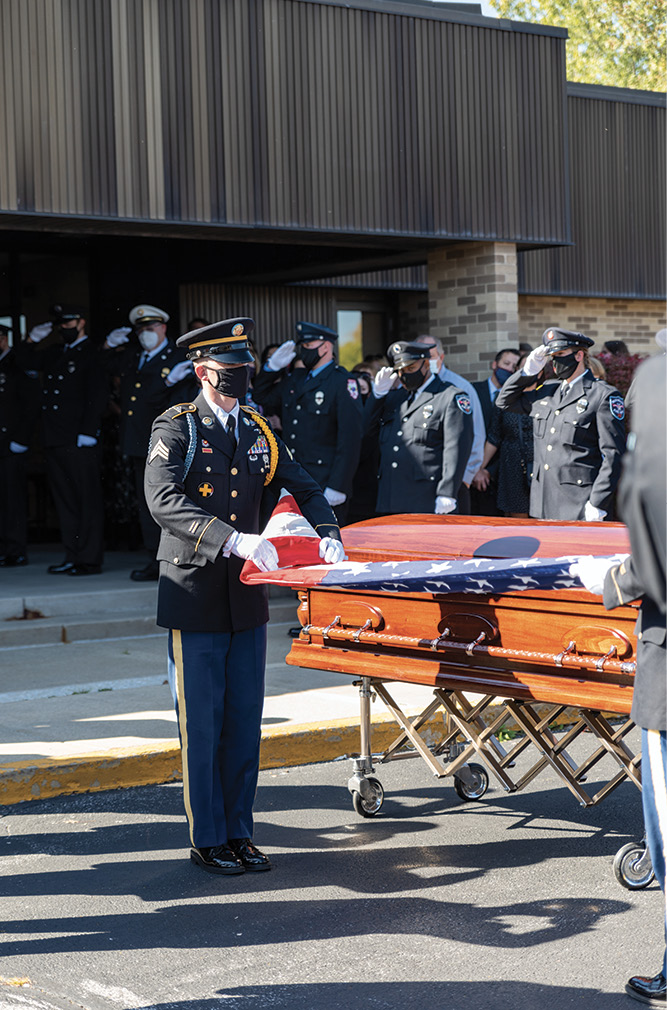
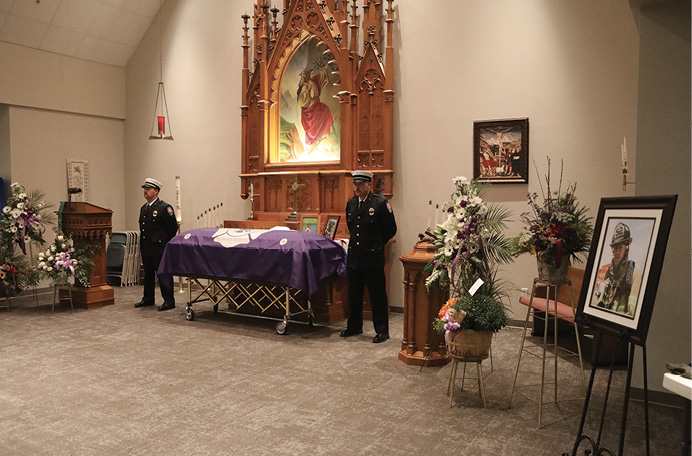
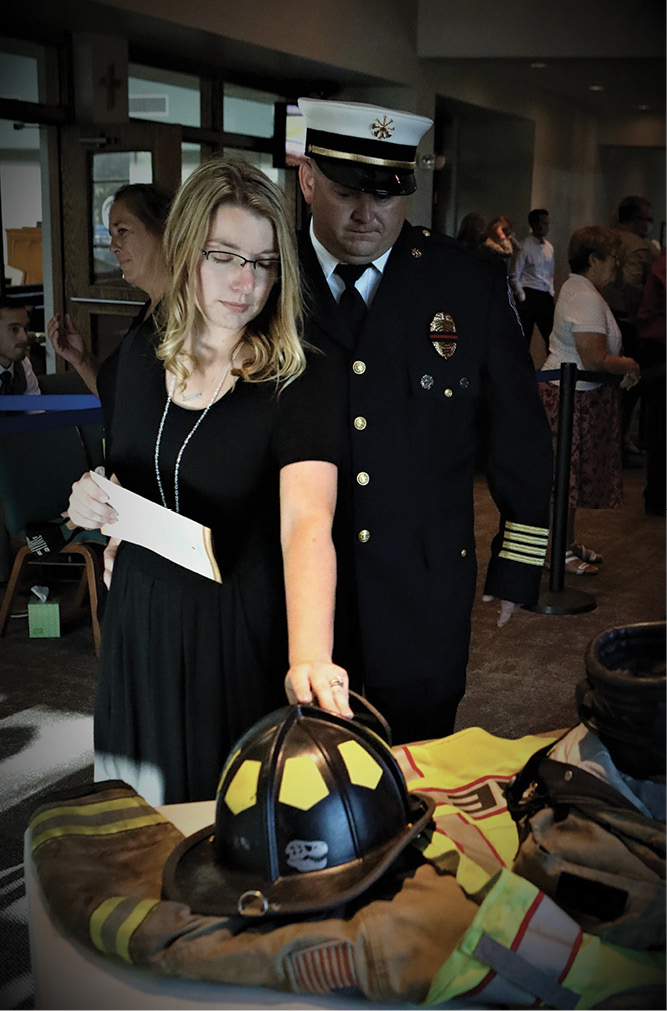
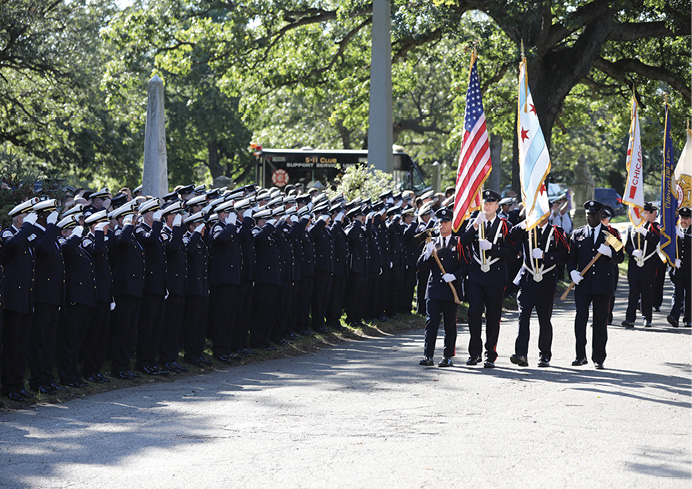
Notifying the deceased’s immediate work group may best be done at a team meeting. Compassion and factual, nonspeculative information about the incident are important hallmarks of your discussion. Allowing your team to ask questions and talk about the deceased and the events surrounding the passing are important to healing. Be sure to have water and tissues available during your meeting; providing food after the meeting is also helpful in providing comfort and establishing community. It also may be appropriate to make chaplain support and critical incident stress management (CISM) peers available on site after your meeting and for the next few days if possible.
If your agency or department is large with several stations, you may want to inform the larger crew through an official e-mail or memo as soon as possible. This acts as rumor control and shows compassion and concern for both your deceased teammate and your coworkers. The announcement should be factual but contain humanity and compassion. You should provide access to chaplain or counseling support for any crew member who wants it. Although the larger crew may not be stationed with the deceased now, they may have been in the past, knew them socially, or were training classmates. The effect on these members may be as emotionally traumatic as if they were assigned to the same crew at the time of death.
Your crew may not want to talk about the incident during first notification but may want to later. If members don’t want to discuss the incident, don’t force it or they will resent the intrusion and may shut down. Give them the tools to identify whatever form of support they may need, and make it as easy as possible for them to access it.
If your deceased has dependents, it’s not uncommon for their crewmates to want to contribute money to help provide for a family who may have lost all or some of their income. Discuss in advance with your legal counsel what the department’s role is in that or if it should be run through a service-connected charity or organization.
Administration
After initial and time-sensitive notifications are complete, administration becomes the next priority. You’ll want to notify your HR office that one of your members is deceased. This would kick off a series of actions including determination of if the deceased had any life insurance in a benefits package; how much; and what’s required, if anything, on the part of the department to get payment initiated. Once you’ve verified this information, be sure to include it in briefs to senior staff concerned with this case; it may be of interest.
Your deceased member is now no longer employed by the department. Your HR department will determine if the next of kin are eligible for an annuity based on time in service that may make them eligible for retirement pay if the deceased elected a survivor benefits option. If the next of kin aren’t eligible for an annuity, then the deceased may be removed from the pay system, and pay and benefits to any dependent family members may stop. When you are working with your HR department on administration, be sure to determine the status of any unpaid wages and accrued vacation days. Determine if designated beneficiaries, next of kin or otherwise, receive payout of wages and vacation and sick days. Discuss burial benefits with your HR office to determine if the deceased is entitled to a headstone, plot, casket, or any other funerary services at the organization’s expense.
Once you’ve determined all benefits information, someone will need to visit with the beneficiary/next of kin to walk them through the details. An HR officer may be best to explain the details because of the complexity of the information. Explain the death benefits at the next of kin’s residence if possible. The HR staff may explain details, but the staff member assigned as the contact for the family should be present. Hopefully, trust has been established with the contact officer, who can assist the next of kin in assimilating a lot of detailed information and relay questions the family may have later.
Funerals/Memorial Services
Discussion of funeral or memorial services will likely begin within a day or two of the member’s passing. First determine what the next of kin’s wishes are regarding a ceremony: Do they want a service-centric event? Will it be a religious or secular ceremony? Will it be a closed ceremony for family and invited friends or an open ceremony? The next of kin may elect no memorial service at all.
Death of a public safety officer in the line of duty can draw a large amount of public sympathy and attention and frequently draw attendance at the ceremony from sister public safety agencies. Consider these factors when planning the event and selecting the venue. If the next of kin desires an official service, appoint a project officer or planning team to manage it. If the service will include a religious aspect, be sure to include your agency chaplain. The chaplain can provide invaluable guidance in ceremony planning, work with local clergy as needed, and help provide spiritual comfort to the next of kin.
The deceased’s crew likely will want to participate in the ceremony in some fashion. This is natural and healthy; it aids in the healing process, makes them feel a part of the event, and allows them to say final good-byes. If possible, find roles for as many team members as want to participate. Reserve service as pallbearers for close crewmates with a personal connection to the deceased if the next of kin or a will has not already designated who they should be.
However, the need for ushers, honor guard details, drivers, and other roles will provide an opportunity for others to participate. Allow the next of kin to designate any participants they wish; if they can’t or don’t wish to, the funeral project officer or planning team should perform this task.
Always coordinate details in advance such as seating, parking, casket placement, pallbearer duties, and hearse arrival and departure location with the funeral director and venue clergy to eliminate misunderstandings and confusion on the day of the ceremony or service. If you expect that your event will disrupt traffic, draw a large crowd, or otherwise impact the public, coordinate with local law enforcement for assistance if they aren’t already involved.
As much as possible, try to determine if any senior service officers from the decedent’s agency or neighboring agencies will attend. If so, plan for their participation including seating, parking, and if they will have a role in the service.
Make the day as easy as possible for the next of kin. Arrange for them to be picked up and driven to the service, graveside committal, any postservice wake, and back home again. The assigned contact officer should be with them at all times. That person has been the one constant throughout the difficult period and will be a source of trusted support on an exceedingly difficult day.
If a flag is to be presented to the next of kin at the ceremony or graveside, determine who is entitled to receive it and inform them in advance. Tell the recipients that at the ceremonial presentation they are not expected to say or do anything except receive the flag. Next of kin often feel the need to respond at that time, and it can become awkward at the moment of presentation. Your decedent affairs policy should specify who receives the flag and what to do if more than one family member requests a flag; parents and spouses/partners may both request one.
The death of a fellow firefighter is one of the worst possible events a public safety agency can experience. Preplanning, training, and forethought can make a very difficult situation easier and help shepherd the deceased’s crew, family, and organization through the trauma of the event.
Paul Fawcett is a retired U.S. Coast Guard commander who served in a variety of operational and administrative assignments throughout his 25-year career.

